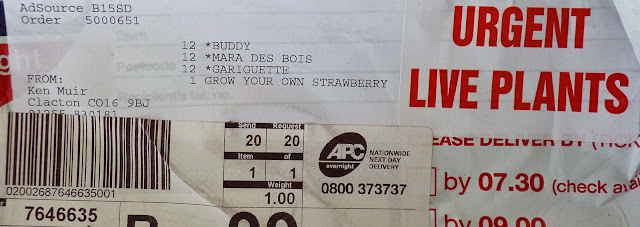Growing vegetables on Leeds allotments - Fertiliser Teas:
Basic Method for "Tea"
Cover material in water, and soak; most recipes "suggest" that you put a lid on the container - this is essential; also do not put the bin by your back door. It will stink.
After a couple of days you will have a weak but useful brew, usable undiluted.
After 2-4 weeks you'll have a stronger brew; this will require a lid and is not suitable for people with short arms!
Stir every couple of days to avoid the brew going stagnant.
Dilute to the colour of weak tea and water in as a plant food, every couple of weeks.
Or use as a spray on plant leaves (a foliar feed).
This process produces a concentrated plant food, and your brew will need to be diluted for use - 1 part tea to 10 parts water for watering in your feed; 1 part tea to 20 parts water to spray on leaves.
Dump the material waste in the compost heap!
Remember - this is only a short-term remedy for plants which need "a bit of a lift"; it won't solve any problems with your soil, as it will be washed away pretty quickly.
Specific Recipes for "tea" brews
Animal Manure
Fill a small sack or cloth bag and suspend this in a container full of water;
rich in nitrogen (especially poultry or pigeon manure) - good for brassicas, onions
Compost
fill a bag or sack, as for animal manure
Seaweed
rinse the seaweed first to get rid of salt
rich in potash (good for potatoes, tomatoes)
Comfrey
cut back the comfrey plants to about 2 inches three or four times a year
pack a dustbin with the cut leaves, and cover with water
rich in potash (good for potatoes, tomatoes), and minerals; good source of nitrogen (for just about anything!)
Nettles
you can make a couple of "harvests" a year from your nettle patch
pack a dustbin with the cut leaves, and cover with water
said to prevent disease, as well as promoting health plant growth
rich in potash (good for potatoes, tomatoes), and minerals; good source of nitrogen (for just about anything!)
Odd recipes
any combinations of the above!
basically anything nitrogen rich, such as fresh grass cuttings
the original cold tea from the teapot! Tea leaves are high in potash
These methods produce a much stronger concentrate, which should be diluted at
1 part potion to 10 or 20 parts water for watering in,
1 part potion to 40 parts water as a spray-on leaf feed.
They also have a couple of advantages, in that they smell less, and the concentrate can be stored (in dark glass bottles, in a cool, dark place.
Using a bucket
Use a plastic container with a hole in the bottom, and fill it with comfrey/nettle leaves. Put a weight on top of the leaves and leave.
After about three weeks a black, very smelly, liquid will drip from the hole.
Collect this in a bottle (shelter the hole and bottle from the rain!).
The concentrate can be stored in the dark for several months.
Using a wormery
The above method is popular among those people who have paid out £50 for a plastic wormery, got fed up with the work involved - and discovered it's perfectly designed for making comfrey concentrate!
Using a piece of drain-pipe!
Fix a drainpipe with wire and brackets to garage wall;
Wedge a 6-pint milk bottle and funnel underneath the drainpipe;
Stuff the drainpipe with comfrey or nettle leaves;
Put a plastic pop-bottle full of water in the top of the drainpipe (attached to a length of string); this will compress the leaves down the drainpipe;
and the concentrate will drip into the bottle, while the funnel keeps the leaves back.
'via Blog this'

